


Web Site by cg-photohraphy.co.uk


Cros-Arc 40 Plasma
Plasma cutter, so what’s my story? Well until about 3 weeks ago I knew very little about plasma cutters. Things like, pilot arc, drag cutting,ip44 connectors what on earth are these? So this is my journey into the world of the unknown so join me and find out!
So why buy a plasma cutter? Well I wanted to fabricate the bench frame in such a way so that I could, use things like, bench vices and grinders, but not have them permanently attached. Like I described on the Bench Design page. So I needed to create some design for the sliding steel box section. The Rage Saw, as described in the Rage Saw page, is great for applying vertical cuts, but not suitable for the horizontal cuts, or for producing the bolted sections that I need for the front box sections. No for this you need a plasma cutter. I also just found out that using one of these goodies, you can actually cut around a cardboard template, without setting it on fire, unbelievable, when you consider that the plasma burns at a temperature of 30,000 C, and yes that is 30K of heat.
I have already purchased a fairly expensive Esab welder for £1,000 (as described on the ESAB Welder page), and simply did not want to spend another £1,200 on an Esab plasma cutter. After all, I am not going to be using it to start a new career in welding and fabrication. I am only doing this for a home workshop project. I started to look about on the Net. What I wanted was a good reliable unit, that could cut up to 10mm or so, in mild steel. I most probably only needed about 6mm for my new bench fabrication. I found a few Chinese imports on E-bay. I then found a video demonstration on YouTube by Graham Rhoades of The Welders Warehouse. Below is Graham’s original video, this is actually an older machine, as I found out that has now been superceded by a much better model. However, I must say that I was seriously impressed with both Graham’s demonstration and the cutting ability of this machine. Take a look for yourself.
Now after seeing this video, I visited the Welders Warehouse website, and gave them a call. Graham told me that the machine used in the video have now been replaced by the Cros-Arc 40. Could this machine be even better? So here is the replacement machine. It can be found here on their website: Cros-Arc 40
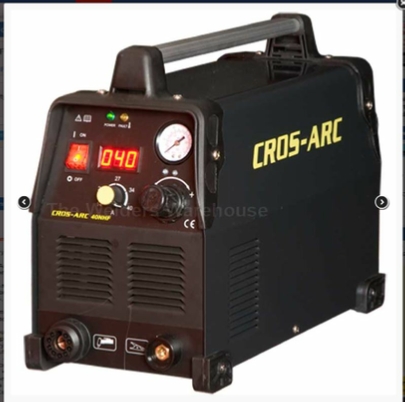
So what is good about this new machine? Well for a start its only £449 Inc Vat! It’s 40 Amp max and can cut up to 16mm in mild steel. As it is an inverter design it only weighs in at 13kg’s so can be moved around the workshop with ease. It also has a built-in air regulator, and unlike a lot of machines the air intake adjustment is available from the front panel. It also comes equipped with the highly acclaimed Trafimet S45 torch. Unlike some E-bay machines whose torches seem to need tie wraps to hold them together. No such problems here.
Now I did have some reservations about some of the features that I could not find listed, but decided to take a gamble and purchase one.
One of the problems that I found on the forums was that the air supply, that is used to direct the plasma stream and cool the torch, on some of the cheaper e-bay units do not have a cut off switch build into the cutter, so has to be manually turned on and off. Again, I found no such problems with this unit. Not only does it control the air flow from the torch trigger turning it on and off, it allows the air flow to continue after the cut has finished so that the torch cutting head can be cooled down.
One other feature, again, not mentioned either in the documentation, or on the WW website is that this unit has a water separator unit built in! This is very important as the air for the cutting torch must be dry. When air is compressed water is forced out, this must be trapped and removed before it entered the cutting torch. Otherwise the cutting steam can be compromised. Again no problem with this unit. Another bonus!
One last issue, and this affects all plasma cutters and welders. Obviously there is a dividing line between home and industrial use. The average home user will only have access to single phase power, and here in the UK it’s 240v. But what about the current being used? This will also be limited by where the equipment is being used, and what sort of power supply cabling has been run from the main fuse box. Bearing all of this in mind, this cutter is supplied with a IP44 16Amp plug. Like the one below.
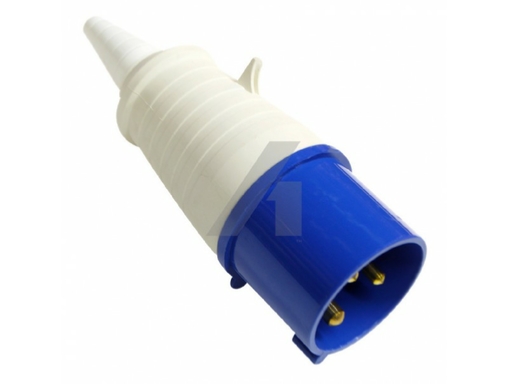
So what I wanted to know was. How much current in amps, will be drawn by this unit when cutting?
Because I could just simply replace the plug with a standard 13Amp Uk one. But would it be safe? Graham had already given me a guide, he rated the cutter as follows: ‘Machine will operate off a 13amp plug up to around 30amps, above that and you start flirting with the fuse. ‘. Very Good advice. But I wanted to get some real figures.
I made up a conversion cable to go from a Standard 13Amp plug to an IP44 trailing socket.
Then using a power meter and some 2mm mild steel plate, did some cutting, and got these results:
Machine set at Amps: Actual current used Amps:
14 11.77
20 13.54
25 14.58
27 15.07
30 15.57
35 15.93
40 16.14
I then did one further test, by double checking if cutting 5mm mild steel bar (the thickest that I have at this time) would increase the current flow used by the cutter. Results were as followers:
Max Current test cutting 5mm mild steel at the 40 Amp setting was a maximum 16.29Amps.
So as you can see, is a 13Amp plug safe to use?
Normally the main ring circuit in a house is wired using 2.5mm cable, this cable is rated at 27Amps, and would be protected by a 32Amp breaker.
However, what type of cable do you have running to your garage? If you are not sure you would need to have this investigated by a qualified electrician just to make sure.
I have a 6mm supply to my garage so I know mine is safe.
However, don’t forget that you will also need to run a compressor for the air supply, mine uses a 2.5Hp motor and so also needs a 13Amp supply.
The 13Amp fuse in my converter cable feeding the plasma cutter did not blow, in any of my tests. However, I have decided just to be extra safe to add an IP44 16 Amp socket to the workshop via it’s own 20Amp breaker. Unfortunately you cannot buy this item, so I have decided to make one!
Don’t forget that the 16Amp ip44 plug on the plasma cutter does not contain a fuse, so you MUST use a separate breaker, and place it on it’s own supply.
As you can see from the pictures above, this is the ip44 socket that I made from the following parts from screwfix.co.uk
If you want to see a video of the testing that I did, it is below. It was only shot on my iPhone and I did not realise at the time that the microphone would mostly only pick up the sound of the plasma cutters cooling fan, and not so much of my voice.
In the meantime I am more that happy with both my new Cros-Arc 40 plasma cutter from ‘The Welders Warehouse’ the service that I received, (the cutter was sent by next day courier), and especially the technical advice given by Graham.
Bottom line is. If you want a great product and a very good price this is the one to get.
Chris
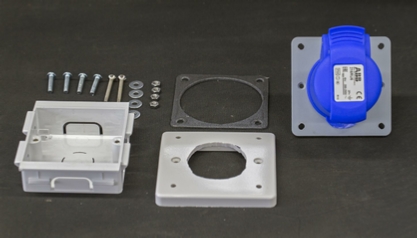


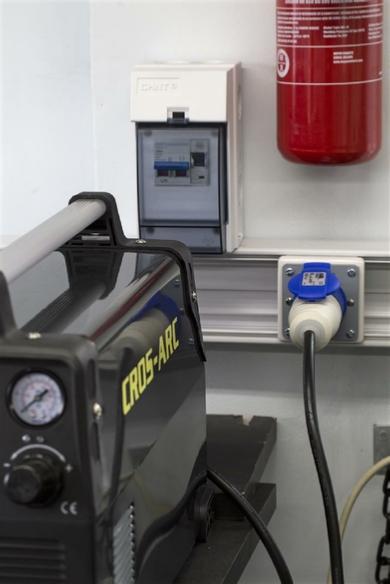
At the top of this page I mentioned some other terms like Pilot Arc, and Drag cutting, so what exactly are these, and are they important? Well as I found out yes, and just to reassure you; does the Cros-Arc have both, well of course it does.
So pilot arc, is the ability of the plasma cutter to strike an arc on the torch without it making contact with the cutting surface. Why this could be important can be seen in the short video clip, which shows some of the bad things that you might get with a cheaper E-bay import.
So you saw in this video clip, some of the problems with not having the air separator built in, and what happens when you do not have a pilot arc. By the way Paul’s, ‘Adventures in Welding’, video the full version can be found here on YouTube. Remember what I said about using a plasma cutter to cut round cardboard. Well take a look at this next video, and just imagine doing this without a pilot arc or tying to cut expanded metal! Nightmare!
Hopefully that explains a little about why you need to have the Pilot Arc, so what about Drag Cutting. The best way to to perform a consistent cut is to maintain a cutting distance from the metal to touch tip of about 1-2mm. I don’t know about you, but I am not sure I could maintain that sort of consistency. The Trafimet S45 touch is supplied with a cutting guide to help you maintain this distance, see the pictures below.
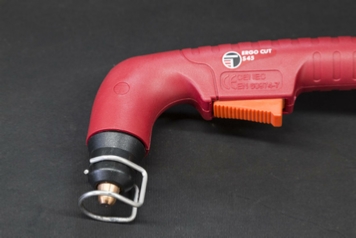
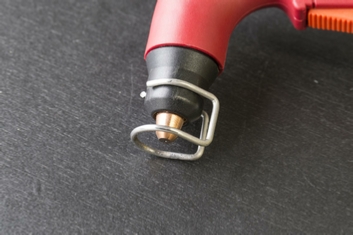
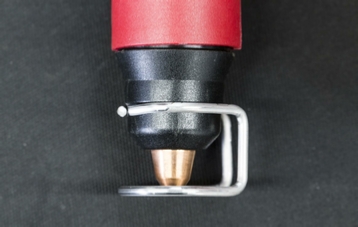
If you take a look at the picture on the left, you can see that with the guide fitted, the the cutting tip is held away from the metal as you cut. This is better shown with the two pictures below.
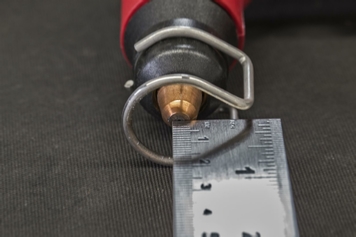

As you can see the distance is about 1.5mm, from touch to metal. So what about drag cutting then. This is when you dispense with the touch guide and cut with the torch tip actually in contact with the metal you are cutting. However, some of the cheaper cutters cannot do this, so beware! The Cros-Arc can of course! However, the cut will not be as refined. In other words, you will get a slightly larger cut, and with more dross. This should not be too much of a problem with thinner material. Take a look at the pictures below. This was a drag cut on a piece of scrap 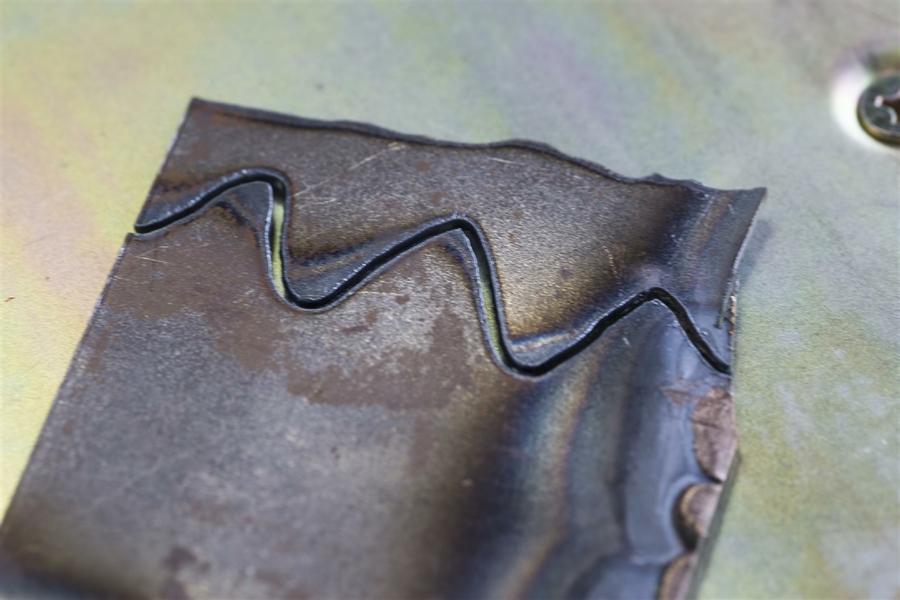 2mm mild steel.
2mm mild steel.
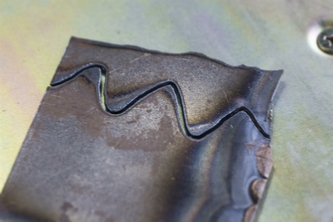
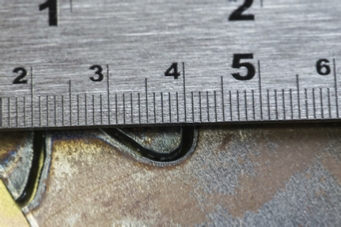
All my cutting so far was using the standard S30-S45 cutting tip this has a 0.8mm cutting diameter. As you can see above this tip has produced a slightly larger cut. This could have been due to the fact I was drag cutting, that I had the cutting current to high for the metal thickness, or I was not moving the touch fast enough, or even the air pressure I was using. All of these things will affect the finished quality of the cut. So, just like doing anything it’s a matter of learning how to do it, setting the equipment up correctly, and then it’s down to practice, and the quality of the equipment that you are using.
Here is a close up of the 5mm mild steel bar that I used for my final cutting test. The picture on the left is from the top, the picture on the right, is from below after the dross was removed.

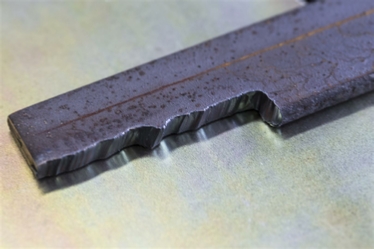
Two other things to remember, if you are trying to pierce a solid piece of metal with the cutter, hold the torch at an angel of 45 degrees until you cut though, then hold the torch square to the metal as you cut. The 45 degree angle is to stop the molten metal from being directed back up into the touch. This will shorten the life of the cutting tip and the electrode.
The last thing to remember is that the cutting stream of molten that is produces from below the metal as you cut should be trailing the cut at a angle of 10 to 20 degrees. If the stream is directly down, you need to speed up your hand movement, because you are moving too slowly. if this stream is being directed upward you must go more slowly, as you are not cutting completely though the metal, and again you could be shorting the life of your consumables.
Don’t forget safety.
Remember that the plasma emitted from the torch head is at a temperature of 30,000 degrees Centigrade. As well as this, some UV light is also produced, not to mention the molten metal that is produce from the cutting process. I have found that wearing a pair of fire proof overalls, which I use for wending, gloves, and a pair of number 5 shade glasses, all works well together. I also use a pair of TIG gloves, as these are thinner, and allow for better hand movement than welding gloves. Boots are another option, as molten metal will make a heck of a mess of those trainers.
So have fun but be safe.
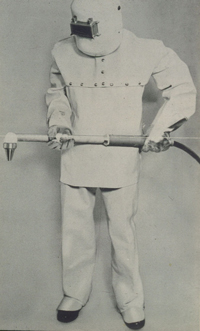
Although wearing safety gear is not mandatory, it is a good idea!
I came across the video below and decided to include it. It has a lot of basic information, especially about the Trafimet S45 torch and how to use it within the plasma cutting environment.
If you have already seen this page and want the March 2019 update skip down on this link:
The above page was written, right at the beginning of when I started to setup, and use the workshop for the first time. I was trying to carefully decide what equipment to purchase, to get the best value for money, and what equipment would suit me best for the type of work I would be doing.
I think I have said before, I did not just want to purchase a cheap welder or plasma cutter that I had no backup or support for. These are expensive items.
One of the things that I liked about the Cros_Arc 40 was the supplied torch, which was Trafimet, one of the best you could get, and the fact the Welders Warehouse were an established English company, operating from Milton Keynes since 1993. I found a video on YouTube demonstrating the product, and when I telephoned for some more information I found I was speaking to Graham, the very person that had demonstrated the product in the video!
At that point I know, this was a company that I wanted to do business with, and so purchased the Cros_Acr 40 plasma cutter. I set about installing a dedicated 32Amp fuse box and IP44 socket (see the above page).
The plasma cutter was a joy to use right from the beginning, absolutely no problems at all. In fact it was so quick to use It became my go to cutter, as it was so fast. Even cutting within 0.5mm on the plate steel for my Tool Cabinet Wheels project, and cutting a large arc for my Belt Sander Pulley Modification project.
Then one day when I turned it on this happened, although the unit worked fine, the amperage read out was permanently stuck at 000. See picture below:
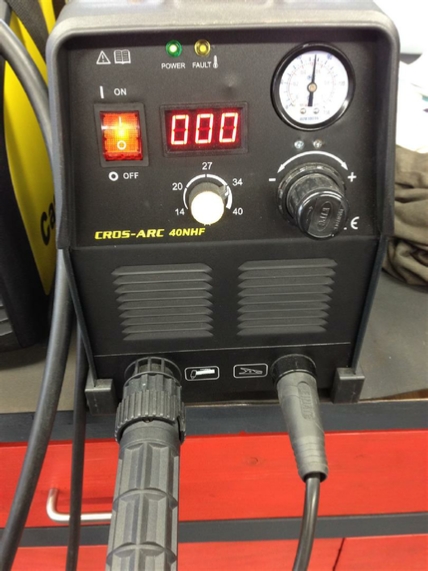
I thought this was strange, however I continued with the job at hand.
The next day I continued with the plasma cutting, only to find out that now a pilot arc would not start when I pulled the trigger on the plasma gun?
First of all a warning:
The type of voltages generated inside a plasma cutter unit are very high 5,000+ volts.
Under no circumstances should you remove the case, when the unit is in operation.
You have been warned.
Not withstanding what I have written above. I have been doing electronics since I was 14 years old, and I like to think I know what I am doing.
I did remove the case and run the unit, being very careful with what I was doing. I found that one of the LED’s was lit on one of the circuit boards, the pilot arc was still not working however.
I did note that the unit was very well constructed, all of the PCB plugs and sockets were in fact painted over and sealed to stop them coming loose.
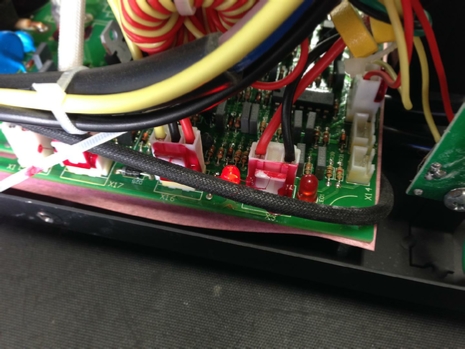
Check out the lit led bottom centre.
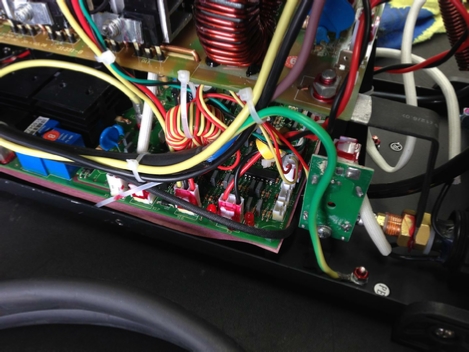
As I could not find anything loose,
I moved one of the small toroidal transformers that was tie wrapped and four of the wires that were nearby and the LED went out and the pilot arc came back into life and so did the display.
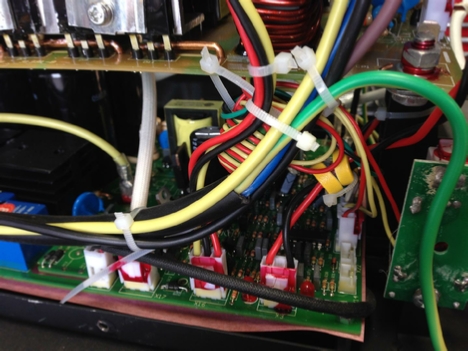
So what I did was add two more tie wraps to permanently move both the transformer and those four wires, out of the way.
See the picture opposite
I then replaced the unit cover.
Now this was back in August 2018, last year. Since then the unit has performed faultlessly ever since. If you check out the project dates both for the Equipment Projects, and Project you will note that most of these utilized some form of plasma cutting, some of the most demanding in fact.
So do I still recommend the Cros_arc plasma cutter, yes, yes, yes! and here is why;
When I contacted Welders Warehouse and spoke to Graham, he asked me to phone their wholesale supplier and I spoke to Brandon, at Weldfast UK Ltd.
I was concerned as my two year warranty was nearly up, Brandon reassured me, that he would extend the warranty until I had finished the project I was working on, so that my client would not be let down. He also told me that they would pay the shipping cost both ways, and the full repair cost.
In fact I decided not to return the unit as it was working just fine, and has continued to do so, to this day, what I didn’t want was the unit bouncing around over two courier trips.
Brandon then said that as the unit was now out of it’s two year warranty, if I have any further problems, we could come to some arrangement on the price.
I have to say that this is why you should always purchase your equipment from a good reliable company.
I am very happy with the response that I had from both Graham and Brandon.
To this day the Cros_Arc has not missed a beat since.
Would I recommend Welders Warehouse, a wholehearted yes I would.
Chris
| Rage 3 Saw |
| ESAB Welder |
| Cros-Arc Plasma |
| HHO |
| Spot Welding |
| Betty's Gates |
| Car Headlights |
| Julia's Dartboard |
| Outside Light Base |
| Weather Vane |
| Geoff's Gates |
| Loft Hoist |
| Colin Laser Mount |